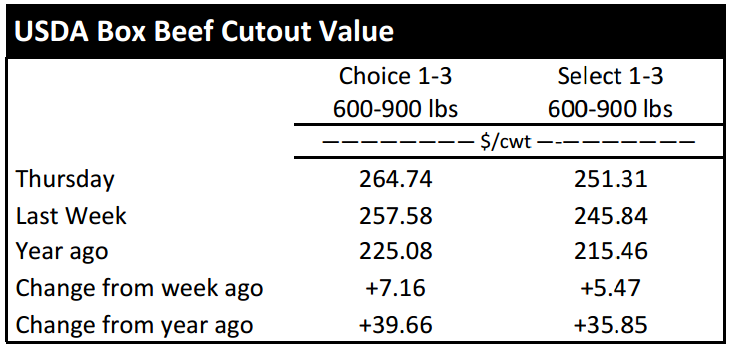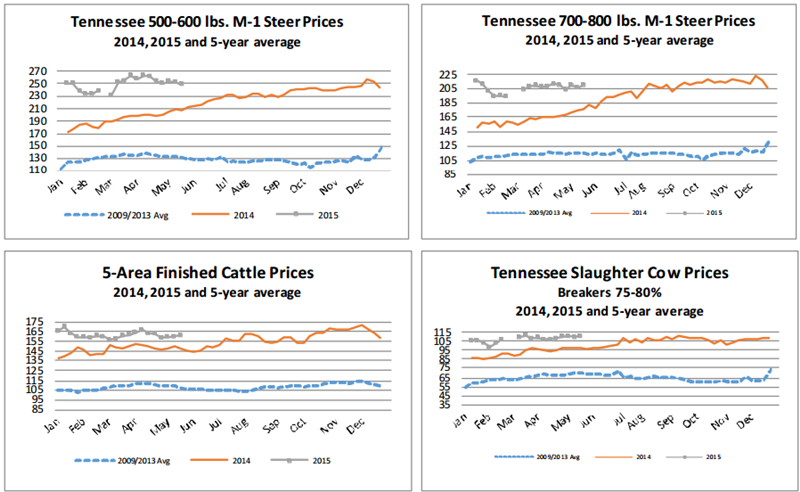Market Highlights: Cattle Prices Down From Earlier in Year

Cattle prices are up from last week, but aren't as strong as earlier prices this year.
By: Andrew P. Griffith, University of Tennessee
FED CATTLE: Fed cattle trade was not well established at press. Asking prices were around $163 in the South and $260 in the North. The 5-area weighted average prices thru Thursday were $160.82 live, up $1.05 from last week and $256.55 dressed, up $1.51 from a week ago.
A year ago prices were $146.95 live and $234.06 dressed. Fed cattle cash prices have traded in a $2 to $3 price range the past five weeks. This is a relatively steady cash price relative to much of the price fluctuation experienced the past 18 months.
It appears prices want to strengthen slightly, but it is likely due to the relative strength in the beef cutout price. It is doubtful fed cattle prices will challenge the spring high of $167.57 which occurred the last week of March and even less likely prices will surge to the current yearly apex of $169.67 which occurred the first week of January.
Fed cattle prices will most likely follow their seasonal trend and start tailing off through the summer.
BEEF CUTOUT: At midday Friday, the Choice cutout was $262.69 down $2.05 from Thursday and up $4.49 from last Friday. The Select cutout was $250.52 down $0.79 from Thursday and up $3.68 from last Friday. The Choice Select spread was $12.18 compared to $11.35 a week ago.
The month of May tends to be a leader for beef demand which is a function of both quantity and price. The quantity of beef that will be purchased in the month of May is not known at this time. Similarly, the average price of beef for the month is not known. However, packers have been wildly successful at pushing wholesale beef prices higher as retailers and food service participants are making last efforts to secure inventory before Memorial Day weekend which is the unofficial start to summer and the grilling season.
The ability of packers to push wholesale beef prices higher at a time when pork and poultry prices have moderated will make it increasingly difficult for retail facilities to feature beef products over relatively inexpensive meat protein alternatives.
The increase in boxed beef prices will continue to support higher retail beef prices. Consumers continue to purchase beef given current beef prices and other economic factors. However, a change in any number of factors such as fuel prices or export demand could change the tide of beef markets rapidly.
TENNESSEE AUCTIONS: On Tennessee auctions this week compared to a week ago steers and bulls were steady to $5 lower. Heifers were steady to $6 lower. Slaughter cows were $1 to $2 higher while bulls were steady. Average receipts per sale were 644 head on 9 sales compared to 678 head on 9 sales last week and 658 head on 12 sales last year.
OUTLOOK: Most of the state has experienced three consecutive weeks of precipitation free weather. The dry weather provided crop producers the opportunity to plant corn while many livestock producers were able to harvest hay without the threat of rain. However, current conditions are shaping up to present hardships for both row crop and livestock producers.
Looking back the past six months, winter precipitation was above average while spring precipitation has been below average. As of May 12th, nearly 21 percent of the state is experiencing “abnormally dry” conditions. The lack of rainfall in early spring coupled with several cold nights has resulted in a short hay crop for many producers across the state.
Some producers are experiencing hay yields that are only 60 to 80 percent of their average yields. Similarly, the dry conditions have put some soybean producers on the sideline until some moisture is in the soil. Not to be overlooked, the lack of rainfall is also negatively impacting pasture conditions in the state. This is not to say that pastures are overly stressed, but rather that cool season pastures are not producing to their full potential due to a lack of moisture.
Pastures may not be stressed yet but another week or two of dry weather will certainly stress pastures. Additionally, time is running short for cool season pastures to produce significant forage before being slowed due to summer temperatures.
On the opposite side of the spectrum, drought conditions in Oklahoma and Texas have moderated significantly due to plentiful rainfall the past two weeks. Rainfall in the Southern Plains bodes well for continued beef cattle herd expansion and thus the price of bred females and breeding age heifers. There is no need for Tennessee producers to begin panicking about the dry conditions yet, but this is a good time to begin evaluating alternative feed resources, potential marketing opportunities, and other management decisions that may have to be made if dry conditions persist for several more weeks.
TECHNICALLY SPEAKING: Based on Thursday’s closing prices, June live cattle closed at $153.80. Support is at $152.58, then $150.15. Resistance is at $155.00 then $157.43. The RSI is 59.98. August live cattle closed at $152.07. Support is at $151.12, then $149.24. Resistance is at $152.99, then $154.87. The RSI is 61.51. October live cattle closed at $153.08. Support is at $152.90, then $151.75. Resistance is at $153.20, then $154.90. The RSI is 60.82. May feeders closed at $219.25. Support is at $218.80, then $217.90. Resistance is at $219.70 then $220.60. The RSI is 65.26. August feeders closed at $218.95. Support is at $218.09, then $216.54. Resistance is at $219.64 then $221.19. The RSI is 60.50. September feeders closed at $218.03. Support is at $216.53, then $215.33. Resistance is at $218.10 then $218.33. The RSI is 60.08. Friday’s closing prices were as follows: Live/fed cattle –June $52.53 -1.28; August $150.80 -1.28; October $151.68 -1.40; Feeder cattle - May $219.00 -0.25; August $218.40 -0.55; September $217.53 -0.50; October $216.65 -0.48; July corn closed at $3.66 down $0.03 from Thursday.











